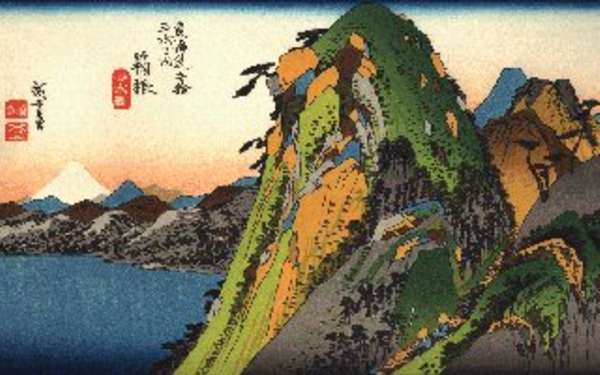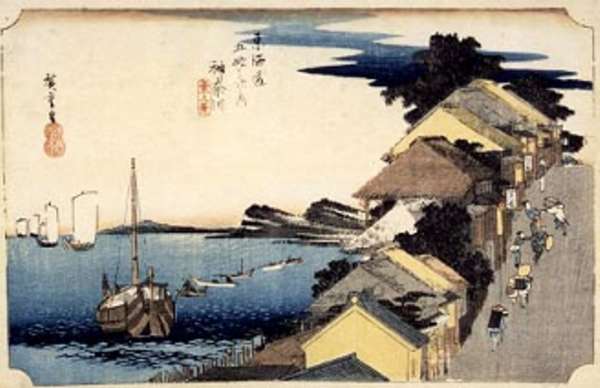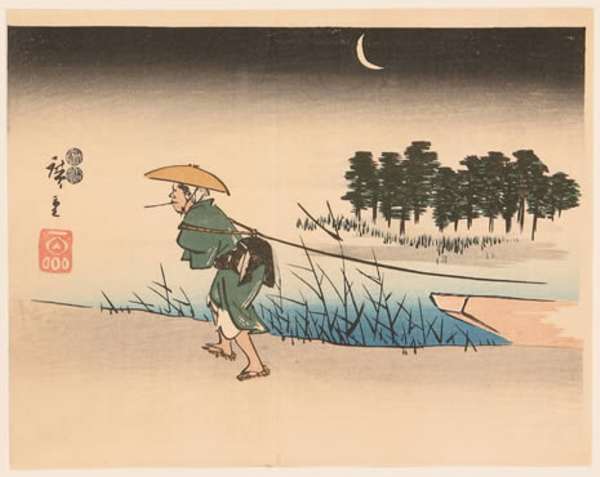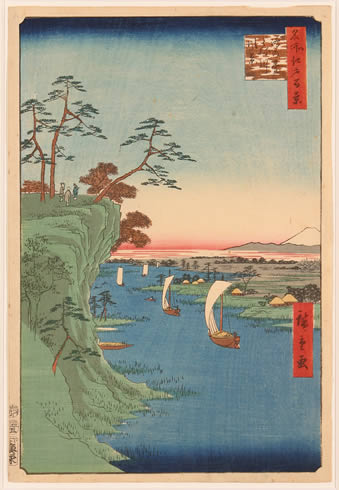
MARCH 2004
ANDO HIROSHIGE ACCUSED OF PLAGIARISM IN NEW BOOK
Ukiyoe artist, Ando Hiroshige was born in Edo (actual Tokyo) in the 9th year of Kansei era (1797). At first, he learned to paint from Utagawa Hiroshige, then formed his own style by learning even from Western schools. The success of the series, Tokaido-Gojyusantsugi made definitive his fame as a landscape painter.
Hiroshige's work represents ukiyoe, a movement in Japanese art to depict "pictures of the floating world". In other words his prints and paintings attempted to express the ambiguous elements of nature: light, wind, rain, fog.

During Edo period, in order to control strictly each seignior, the shogunate forced them to do a trip every year between their feuds and Edo (actual Tokyo). As a popular song tells "Hakone is the steepest pass of Japan", it was the most difficult passage of Tokaido road which has linked Tokyo and Kyoto. Now a cortege of seignior is passing in silence in mountains of Hakone
Famed ukiyo-e artist Hiroshige a copycat?
The Asahi
Shimbun
| You probably have seen Utagawa Hiroshige's
gorgeous ukiyo-e woodblock prints depicting stops
on his famed journey from Edo to Kyoto on the old
Tokaido road. It's easy to imagine how the master himself must have admired much of the same scenery familiar today and sketched away, creating his famous series of masterpieces from real life. Not exactly, say experts. A new book published by Iwanami Shoten on Jan. 23 says Hiroshige (1797-1858) probably never set eyes on at least 26 of the 53 scenes depicted in ``Tokaido Gojusantsugi'' (53 stages of the Tokaido). The actual series runs to 55 woodblock prints,
devoted almost entirely to scenes on the ancient
highway from what is now Tokyo to Kyoto, covering
about 488 kilometers down the Pacific coast. Hiroshige, it is commonly believed, traveled the Tokaido to Kyoto in 1832 in a long annual procession for Tokugawa Ienari to present the 11th shogun's best horses to Emperor Ninko (1800-1846). Hiroshige is supposed to have executed the series the following year. While ukiyo-e traditionally depict scenes of everyday Edo Period life, entertainment areas and Kabuki, for example, Hiroshige's series concentrated on landscapes during what must have been an epic journey for those days. However, three ukiyo-e experts insist the accepted idea that Hiroshige reached Kyoto is not based on hard facts. The notion developed from the book ``Hiroshige'' written by Minoru Uchida in 1930. Juzo Suzuki, 84, an independent ukiyo-e researcher; Junichi Okubo, an assistant professor at the National Museum of Japanese History; and Yaeko Kimura, professor at Kinjo Gakuin University, say there is no record to validate claims made in the book. Uchida based his theory on a newspaper story that said one of Hiroshige's disciples in the Meiji Era (1868-1912) had actually heard about the journey from the master himself. Still, Suzuki is not convinced. He says no record of the journey appears in Hiroshige's family history ``Ando Ke Yuishogaki Shitagaki'' from 1866, nor in the Ukiyo-e Rui Ko database on ukiyo-e artists. Suzuki first published his doubts about the journey in his book ``Hiroshige'' in 1970. He pointed out that Hiroshige's works bore an uncanny resemblance to prints in ``Tokaido Meisho Zue'' (beautiful spots in Tokaido) published in 1797. He cited three works in particular- ``Ishibe,'' ``Sakanoshita'' and ``Kanaya.'' After a careful examination of all 55 ukiyo-e
woodblock prints, Suzuki concluded that 19 were
based on ``Tokaido Meisho Zue.'' In addition, Suzuki, Okubo and Kimura believe six works were inspired by the novel ``Zoku-Hizakurige'' written by Jippensha Ikku in 1813. They also said two prints appeared based on ``Ise Sangu Meisho Zue'' (beautiful spots in Ise Sangu), published in 1797. Suzuki noted that the passengers in Hiroshige's ``Kawasaki'' resemble those in a ferryboat in an illustration in ``Zoku-Hizakurige.'' While the position of the passengers is different, three look very similar, especially a man smoking a pipe. In Hiroshige's ``Kuwana,'' the design of the ship and the castle appear to have been inspired by ``Ise Sangu Meisho Zue.'' ``Hiroshige's pictures lack reality once he was west of Suruga (Shizuoka Prefecture),'' said Okubo. ``His pictures were more genre-style, not like ukiyo-e at all. It looks like the latter half of Hiroshige's prints were drawn in haste.'' Okubo said the influence of ``Tokaido Meisho
Zue'' became more evident in those pictures. Hiroshige, in fact, only became popular after he published the Tokaido Gojusantsugi series. ``At the end of the day, though, it hardly matters whether Hiroshige made the journey,'' Suzuki said. ``If he did, his artworks attest to his greatness. And if he didn't, that's even better because they display his genius. ``Hiroshige was no fly-by-night artist. He
gained a great reputation because he was a great
artist.''(IHT/Asahi: February 5,2004) (02/05)
|



